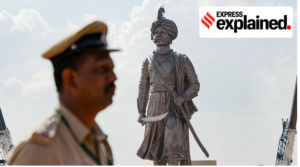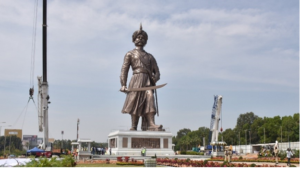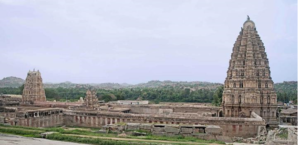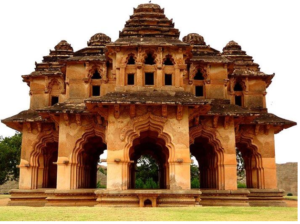PM Modi unveils Kempegowda statue in Bengaluru
Why in News?
Prime Minister Narendra Modi unveiled the statue of Nadaprabhu Kempegowda installed at the Kempegowda International Airport in Bengaluru.
- Called the Statue of Prosperity, it weighs 220 tonnes and has a sword with a weight of 4 tonnes.
The structure has been termed the “first and tallest bronze statue of a founder of a city” by the World Book of Records.
About Kempegowda:
He was a 16th-century chieftain under the erstwhile Vijayanagara Empire. He is credited with laying the foundation of what is today known as Bengaluru city in 1537. He is revered in parts of southern Karnataka, especially by the Vokkaliga community which is dominant in the Old Mysuru.
His Achievements:
- Against Social Evils: Nadaprabhu Kempegowda abolished the practice of cutting the fingers of the left hand of an unmarried woman during a custom known as Bandi Devaru.
- Infrastructure: Kempegowda is also known to have developed around 1,000 lakes in the city to cater to drinking and agricultural needs.
- Literature: The ruler knew multiple languages, besides Kannada, and even authored a Yakshagana play in Telugu named Gangagaurivilasa.
About the Statue:
Ram Vanji Sutar, renowned sculptor and Padma Bhushan awardee, designed the statue. Mr Sutar had also built the Statue of Unity in Gujarat and the statue of Mahatma Gandhi in Bengaluru’s Vidhana Soudha.
The Age of Vijaya Nagara (1336-1647) AD :
In 1336, Vijayanagar kingdom was established by Harihara and Bukka, who were two brothers and served in the army of Muhammad-bin-Tughlaq. They broke away from the Delhi Sultanate and established an independent state in Karnataka and established the capital city Vijayanagar on the banks of river Tungabhadra in 1336.
Harihara and Bukka were helped and inspired by contemporary scholar and a saint Vidyaranya for the establishment of their kingdom.
Sources:
- Literary Sources:
- Rayavachakam by vishvanatha sthanapati
- “The forgotten history of vijayanagar empire” by Robert seawell
- The Kannada and Telugu literature, like Manucharitram, Saluvabhyudayam, etc., patronized in the Vijayanagar court, give genealogical, political and social information.
- Foreign Accounts:
- Nicholo de conti visited Vijayanagar durinh times of Devaraya 1 and gave details about his personality.
- Abdul Razzaq from Persia visited during Devaraya 2. He described the beauty of capital city Hampi.
- Domingo Paes and Barbosa visted during Krishnadevraya time.
- Nuniz visted during the times of achyuthdevaraya
Inscriptions:
- Bitragunta inscription is the major source for construction of family history of sangama dynasty.
- Srirangam copper plates of Devaraya II provide the genealogy and achievements of Vijayanagar rulers.
- Various copper plate inscriptions of krishnadevraya time.
- The Hampi ruins and other monuments of Vijayanagar provide information on the cultural contributions of the Vijayanagar rulers.
Political History :
- Vijayanagar was ruled by four different dynasties
- Sangama dynasty(1336-1486)
- Saluva dynasty(1486-1506)
- Tuluva dynasty(1506-1565)
- Aravidu dynasty(1570-1647)
- Sangam Dynasty:
- Harihara raya was first ruler. Vijayanagar and Bahamani conflict started during his times.
- Bukaraya ascended throne after harihara.
- Bukka’s son kamparaya annexed Madurai. This episode was written by Gangadevi(wife of kamparaya) as Madhuravijayam in Sanskrit.
- He captured revatidweepa(Goa).
- He created Pansupari bazaar in Hampi
- Bukaraya was succeeded by harihara 2 and later Devaraya came to power
- Devaraya 1 was the first important king. He was the first to construct dam across river Tungabhadra
- Devarya 1 was defeated by Bahaman sultan Feroz shah 1.
- The greatest ruler of the Sangama dynasty was Deva Raya II.
- He inducted muslim archers into army.
- He was first vijayanagara ruler to collect tributes from cylon.
- After his death, Sangama dynasty became weak.
- The last king virupaksharaya was dethroned by his commander Saluva Narsimharaya 1, and he stared Saluva dynastic rule.
- Saluva Dynasty:
- Narasimha raya 2 was the greatest in saluva dynasty.
- Annamcharaya lived during this time period.
- After the death of Narasimha 2, Narasa nayaka installed his son veeranarsimha on throne.
- Veeranarasimha started rule of Tuluva dynasty.
- Tuluva dynasty:
- After the death of Veeranarasimha , prime minister Thimmarasu installed Krishnadevaraya on throne.
- Krishnadevaraya (1509-1529)was the greatest in this dynasty.
- He was a great commander and an efficient administrator. He fought a series of war with the independent kingdoms that came on the ruins of the Bahamani kingdom, maintained law and order and dealt with the Portuguese influence in the Deccan.
- He completely shattered the Adil Shahi forces of Bijapur first and attacked Gulbarga and set free three Bahamani princes who were imprisoned there. He helped them in recovering the throne of Gulbarga and Krishna Deva himself took the title of Yavanarajya sthapanacharya.
- He started his eastern campaign in 1513AD.
- Udayagiri was the first fort to be captured by Krishnadevaraya.
- He defeated Prataparudra Gajapati of Orissa.
- He married Gajapati princess Tukkadevi or Annapurnadevi.
- Raichur campaign in 1520 was his last campaign. He defeated Ismail Adil shah.
- Portugese governor Alfanso de Alburque concluded treaty with Krishnadevaraya.
- In 1510 Portugese captured Goa from Bijapur Sultan.
- He was a great patron of literature and art and he was known as Andhra Bhoja
- Eight eminent scholars known as Ashtadiggajas were at his royal court.
- Due the death of his son ,Krishnadevaraya received nervous breakdown and passed away in 1529.
- After his death, Achyutadeva and Sadashivraya succeeded the throne.
- During the reign of Rama Raya, the Bahaman confederacy (combined forces of Bijapur, Ahmadnagar, Golkonda and Bidar) defeated him(Ramaraya) at the Battle of Talaikote in 1565.
- Rama Raya was imprisoned and executed. The city of Vijayanagar was destroyed. This battle was generally considered to mark the end of the Vijayanagar Empire.
- However, the Vijayanagar kingdom existed under the Aravidu dynasty for about another century.
- Aravidu Dynasty:
- Thirumala, Sri Ranga and Venkata II were the important rulers of this dynasty.
- Venkata II was contemporary to Akbar. He shifted capital city to
- The last ruler of Vijayanagar kingdom was Sri Ranga III.
- Sri Ranga was defeated by Mir Jumla of Golconda in battle of Vandavasi in 1647.
- Vijyanagar empire came to an end with this.
Administration :
- They followed traditional monarchy.
- The king was the ultimate authority in the kingdom. He was also the supreme commander of the army.
- The king was assisted by a council of ministers in his day to day administration.
- One of the important characteristics of the Vijayanagar administration was the amaranayaka This is similar to the iqta system of Delhi Sultanate.
- In this system, the commander of the Vijayanagar army was called the nayaka. Each nayaka was given an area for administration. The nayaka was responsible for expanding agricultural activities in his area
- He collected taxes in his area and with this income maintained his army, horses, elephants and weapons of warfare that he had to supply to the raya or the Vijayanagar ruler
- The amara-nayakas sent tribute to the king annually and personally appeared in the royal court with gifts to express their loyalty.
Revenue:
- Land revenue was the major source of income to the state.
- Genrally it was it was at the rate of one sixth of the total produce.
Society:
- People were found of luxurious life.
- Silk and cotton clothes were mainly used for dress. Perfumes, flowers and ornaments were used by the people. Paes mentions of the beautiful houses of the rich and the large number of their household servants.
- Prostitution was institutionalized.
- Devdasi or temple dancer system became more popular.
- Practice of sati further strengthened.
- Existence of four caste- Brahmins, Kshatriyas, Vaisyas and Sudras.
Religion:
- The Sangama rulers were chiefly Saivaites and Virupaksha was their family deity. But other dynasties were Vaishnavites.
- But all kings were tolerant towards other religions. Borbosa referred to the religious
freedom enjoyed by everyone. - Muslims were employed in the administration and they were freely allowed to build mosques and worship.
- Shunya sampadane– a collection of vachanas produced in this age.(vachanas literally meaning sayings in kannada, these are poetic verses composed in kannada language, popularized by veershaiva movement led by Basavanna).
Literature:
- Sanskrit, Kannada, Telugu language witnessed voluminous literature in Vijayanagar period.
- Few Sanskrit works are.
- Gangadevi wrote- Madhuravijayam
- Krishnadevarya wrote – usha parinayan, jambavanti kalyanam, madalasa charita.
- Guru vidyaranya wrote—Raja kalanirnaya
- Literary works in Kannada.
- Chamarasa wrote – prabhulingaleele
- Kanakadas wrote- Ramadhanacharite, nala charite, mohantarangini
- Kumaravyasa wrote – Karnataka katha manjari
- Purandardas — keertanas
- Literary works in Telugu
- Krishnadevaraya wrote – Amuktamalyada
- Allasani pedanna wrote – Manucharita
- Nandi timanna wrote – Parijathaparahana etc
- Ashtadiggajas– eight great poets of Telugu literature flourished in the court of Krishnadevaraya.
Architecture:
- They used the Dravidian style of architecture later added some unique features to it and it came to be called as Vijayanagara style.
- Preferred for its durability, local hard granite was the building material of choice, as it had been for the Badami Chalukyas.
- Vijayanagar temples are surrounded by strong enclosures and characterized by ornate pillared kalyanamandapa (marriage halls); tall rayagopurams (carved monumental towers at the entrance of the temple) built of wood, brick, and stucco in the Chola style; and adorned with life-sized figures of gods and goddesses.
- This dravida style became popular during the reign of Krishnadeva Raya and is seen in South Indian temples constructed over the next two centuries.
- The courtly architecture of Vijayanagar is generally made of mortar mixed with stone rubble and often shows secular styles with Islamic-influenced arches, domes, and vaults.
Some famous temples exemplifying the Vijayanagar style include the Virupaksha Temple at Hampi and the Hazara Rama temple of Deva Raya I etc.
Virupaksha Temple
Hazara Rama Temple
Lotus Mahal
Mains PYQ:
- Krishnadeva Raya, the King of Vijayanagar, was not only an accomplished scholar himself but was also a great patron of learning and literature. Discuss. (UPSC 2016)
Prelims PYQ:
Q . With reference to Indian history, which of the following statements is/are correct?
- The Nizamat of Arcot emerged out of Hyderabad State.
- The Mysore Kingdom emerged out of Vijaynagara Empire.
- Rohilkhand Kingdom was formed out of the territories occupied by Ahmad Shah Durrani.
Select the correct answer using the codes given below.
(a) 1 and 2
(b) 2 Only
(c) 2 and 3
(d) 3 Only
Answer: (a)








